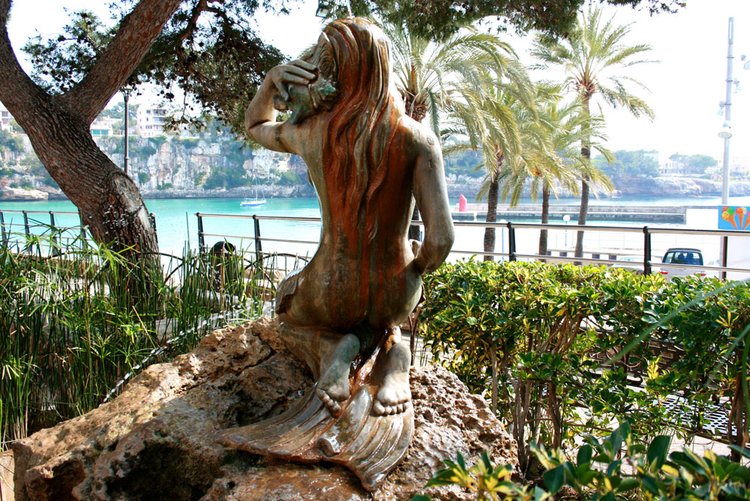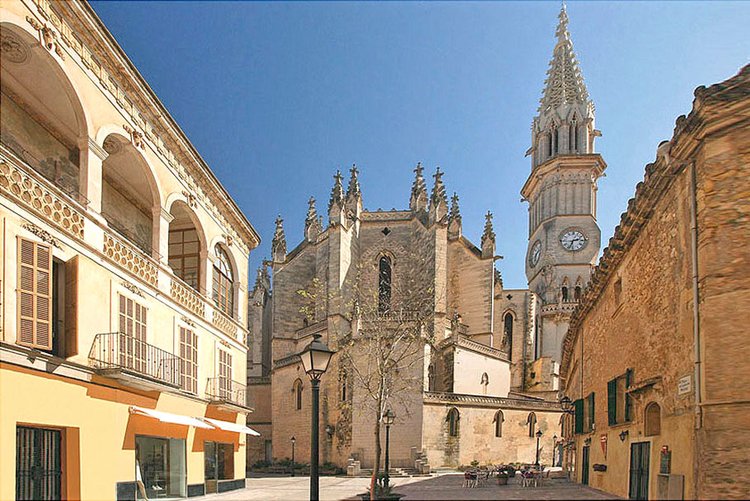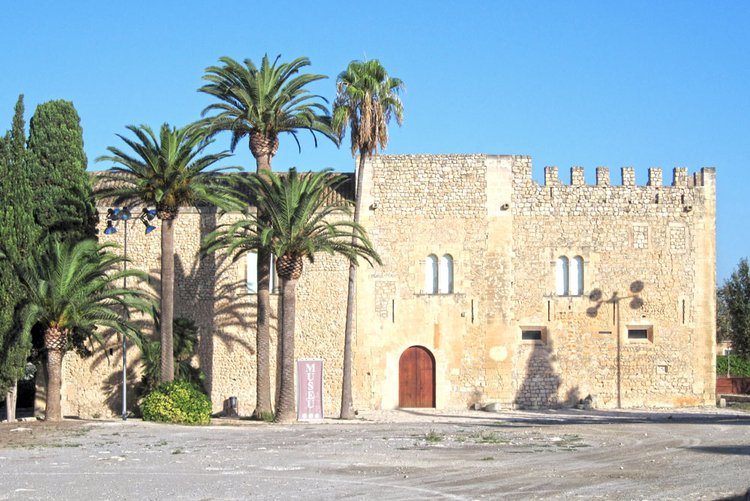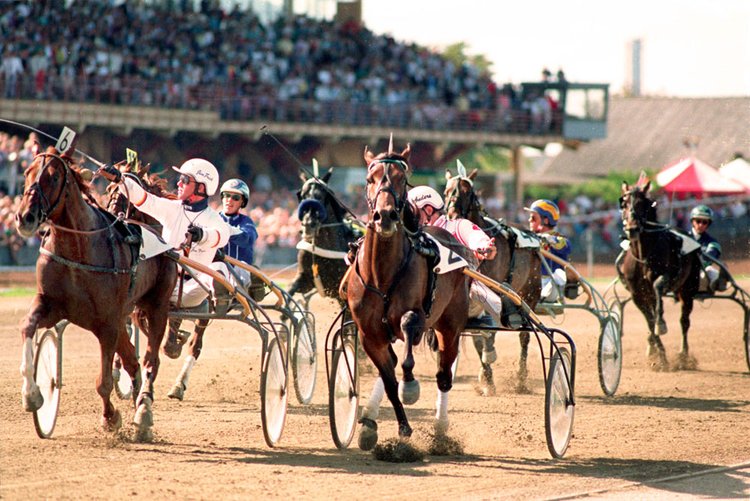Manacor
The 30.000-inhabitant town of Manacor in the east of the island is located off the busy tourist centers and is famous as the center of the Mallorcan pearl industry far beyond the Spanish borders.

The municipality has an area of 260.22 kilometers ². In the south it borders with the municipality of Felanitx, in the west Vilafranca de Bonany, in the northwest of Petra and the north of the Sant Llorenç Cardassar. The coast to the east is 27 km long. In the year 2007, the population reported 37,963 inhabitants, the population density was 145.9 inhabitants per km ². The population is distributed to various localities. 69.2% are concentrated in the town of Manacor, while 17.8% live in Porto Cristo. Here is the rise in recent years is remarkable. The rest is distributed among the settlements S'Illot - Cala Morlanda, Cales de Mallorca, Son Macià, Cala Murada, Cala Anguila - Cala Mendia and Estany d'en Mas. In the course of history behaved population growth of the community similar to that of the rest of the island. In the 16th Century there were about 5,000 inhabitants, and the number rose in the 18th Century up to 7,000. The most significant population growth began in the 19th Century, with nearly 13,000 inhabitants at the beginning of the 20th Century. Between 1920 and 1940 the number increased up to 19.000 and then slowed down the growth. From the 1960s to the present population started to slow again. This last increase is primarily attributable to the immigration wave, which triggered the economic growth was parallel to the development of tourism was held. In 2007, the proportion of foreigners of the commune is now 17.5% (6643 persons), the proportion of German population of 3.9% (1497 persons). In addition, there were 55 Dutch, 46 Swiss and 23 Austrians in the community. The first signs of human settlement in what is now the municipality of Manacor go to the prätalaiotische time (2000 to 1400 BC), even if the arrival of humans on the island of Majorca in the fifth millennium before our era is. From this time the grave artificial caves (cova de Homonet on Sun Ribot, Mitja de les Beies and Navet), alone or in groups, which served as a residential building (see Marineta, Hospitalet Vell). Around 1400 BC there was a structural change in the history of the island instead of one based on the internal development of prätalaiotischen society, as by the arrival of new tribes from the eastern Mediterranean caused. It created a culture that, through its megalithic was coined, of which today only pottery shards testify. There are place names, which in Arabic or Berber origin indicates. The origin of the city of Manacor is probably the Islamic rule, as reflected in the archaeological finds show that in the vicinity of the parish have been made. Already in the year 1300 Jaume II granted the town of Manacor rights. The existence of a parish church was already in the year 1236 documented evidence. From the beginnings of the city are part of a former royal palace, the Torre del Palau, and some fortified manor houses (Torre de ses Punte and Torre dels Enagistes) erhalten. In the Middle Ages Manacor played an important role in the social struggles in which the derived from Manacor Simó Tort was the champion. The urban and social development, particularly through the establishment of the monastery of Sant Vicenç Ferrer and the emergence of neighborhoods Fartàritx marked. Here were the most windmills that have shaped the city. 1576 founded the Dominican Order, the monastery and mentioned the construction of the baroque church began. Beginning of the next century the cloister was built. The ownership of the monks fell in 1835 in the hands of the state. The monastery has since been the seat of the municipality and of the Court. By 19 Century based on the economy Manacore agriculture (cereals and vineyards) and livestock (sheep), although the textile and food sectors as well as the pottery industry played an important role. In the 19th Century began, the changes from Manacor does what it is today. The industries for processing agricultural products increased. In the city released the windmills and a liquor factory. Since the second half of the century, the furniture-making factory and the pearls one of the economic fundamentals Manacor. But the pottery industry and the production of liqueurs and wines are still significant. 1879 was the railway line between Inca and Manacor and 1902 opened the first factory was founded pearls. Thus, Manacor for commercial and industrial center of the east of the island. This economic development not only changed the habits of society, but also affected the city, especially since the beginning of tourism in the 60s of the 20th Century. Towards the end of the 19th Century the new church Nostra Senyora dels Dolors built at the same place as the previous church stands. The oldest of them has already been documented for 1232 and was probably occupied about an Arab mosque was built (discovery of a grave inscription, now in the Museu Diocesà in Palma is kept). The most emblematic element is the bell tower. At the same time, some of the finest mansions in the streets Nou, Major, Pius XII, Bosch, etc. were built, the historic district (Fartàritx and it Barracar) extended and strengthened, and in the vicinity of the station and the Promenade na Camella, new quarters . Today, the growth of the city mainly in the newer districts of the schools and the port promenade, and Ferrocarril Fartàritx instead. Population Development
Attractions
• The prehistoric settlement Hospitalet Vell on the road to Manacor after Cales de Mallorca (1800-1500 BC), a Talayotsiedlung. Particularly noteworthy is the Talayot, a sort of tower with a square floor plan, from the Mediterranean to the pillar and the roof of large stone slabs and a rectangular enclosure obtain. • The early Christian Church Sun Peretó on the road from Palma to Artà was towards the end of the fifth century AD construction. It consists of a church with two of the chapel and baptistery. • The Torre dels Enagistes on the road to Manacor after Cales de Mallorca, Schutzbau and mansion from the 14th Century (after the Catalan conquest in 1229). Today the building is the seat of the Museum of Manacor with an exhibition of Archeology and Ethnology, Manacor. The most notable exhibits include the grave of the mosaic Balèria, one of the mosaics of the early Christian church Peretó Son, and the miniature furniture. In the first floor of 15 graffiti to 18 Century to see. • The monastery and the cloister of Sant Vicenç Ferrer at Convent Place. 1576 The monastery was founded by the Dominican Order. The church was established between the end of the 17th and the beginning of the 18th Century and has the characteristic of the Baroque monastery churches on the island: it has a single nave with eight side chapels between the piers and arch barrel vault. Particularly noteworthy is the pipe organ from the 18th Century. • The church Nostra Senyora dels Dolors Square Rector Rubí. The parish church was completed towards the end of the 19th Century neo-Gothic Historizismusstil built. It stands in the same place, at the earlier churches stood. The oldest has already been well documented 1232 and was probably an Arab mosque was built (Arab Fund a grave inscription, now in the Museu Diocesà in Palma). At the new building are both components as well as art objects by local artists, has been preserved. The bell tower is under the name Torre Rubí known, in memory of the builders of the church. It is grown in the apse, where the previous church was the main portal. It is the tallest building in Mallorca (80m), a Gothic work of the architect G. Bennàssar Moner, with its tower of even the Cathedral of Palma (67.5 m) above. • Windmill Molí d'en Polit from the 19th Century on the main road to Manacor-Palma • Exhibition halls of the pearl factories Majórica and Orquídea Perlas • The caves of Coves del Drac Portocristo. The Martel is one of the largest subterranean lakes in the world where daily concerts of classical music presented. Beaches I Calas Platjas (beaches and bays), which is on the municipality of Manacor located (Listed from north to south): Cala Moreia / S'Illot, Cala Mosca, Cala Morlanda, Caló d'en Rafalino, Cala Petita, Caló de sa Ferradura, Cala Manacor (Platja Porto Cristo), Cala Murta, Magrana Cala, Cala Anguila, Cala Mendia, S'Estany d'en Mas, Cala Falco, Es Caló Blanc, Cala Varques, de sa Teula Racó, Pastor Engana Cala, Cala sequencing, the Serral Caló, Magraner Cala, Cala Pilota, Cala Virgili, Cala Bota, Caló the soldier (Caló des Llamp ), Cala Antena, Cala sa Romeguera, Es Domingos Grans, Es Domingos Petits (Cala Tropicana), Cala Murada See also: beaches and coves on Majorca Markets [Edit] • Fruit and vegetable market on the Plaza Constitució, weekdays, every morning • Weekly on Plaça Ramon Llull, Monday morning Famous sons and daughters of the City [Edit] • Miguel Angel Nadal (* 1966), former footballer • Albert Riera (* 1982), footballer • Rafael Nadal Parera (* 1986), tennis player • Luis Ladaria (* 1944), Jesuit, Archbishop Curia of the Roman Catholic Church























